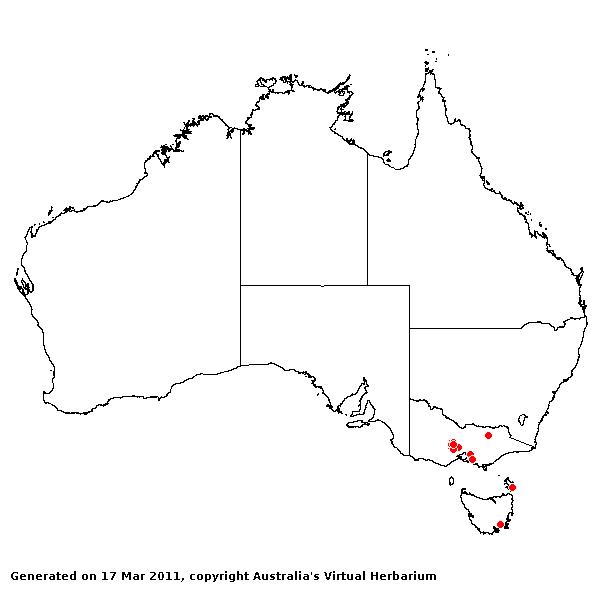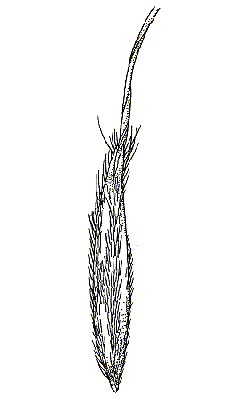Amelichloa caudata* (Trin.) S.W.L.Jacobs
& J.Everett. Sida 22: 148 (2006).
Classification.
(GPWG 2001) : Subfamily Pooideae. Tribe Stipeae.
Basionym and/or
Replacement Name: Stipa caudata
Trin., Mem. Acad. Imp. Sci. St.-Petersbourg, Ser. 6, Sci. Math 1(1): 75
(1830).
Type of Basionym or
Protologue Information: HT: J. Lindley s.n., specimena Chilensia
(LE-TRIN-1392.01 (& fig.) (photo, SGO-73107); IT: BAA-3001 (fragm.),
US-2489479 (fragm. ex LE)).
Recent synonyms:
Achnatherum caudatum (Trin.) S.W.L.Jacobs & J.Everett, Jarava
caudata (Trin.) S.W.L.Jacobs & J.Everett.
Key references
(books and floras): [2002] D.Sharp & B.K.Simon, AusGrass, Grasses of
Australia (as Achnatherum), [2008] S.W.L.Jacobs, R.D.B.Walley &
D.J.B.Wheeler, Grasses of New South Wales (116 as Achnatherum),
[2009] A.Wilson (ed.). Flora of Australia, Vol 44A. Poaceae 2 (13
as Achnatherum), [1989] T.D.Stanley & E.Ross. Flora of South East
Queensland, Gramineae 3 (116).
Illustrations:
[2002] D.Sharp & B.K.Simon, AusGrass, Grasses of Australiia (as Achnatherum
caudatum), [2008] S.W.L.Jacobs, R.D.B.Whalley & D.J.B.Wheeler, Grasses
of New South Wales, 4th edn (116).
Derivation:
from the Latin cauda (tail) and -ata (possessing), referring to
the elongated glumes.
Habit.
Perennial. Culms erect, 55–100 cm tall. Mid-culm internodes glabrous.
Leaf-sheaths glabrous on surface. Ligule an eciliate membrane, 0.1–0.5 mm long,
abaxially pilose, truncate or obtuse. Leaf-blades straight or curved, filiform
or linear, flat or involute or convolute, 25–70 cm long, 1–7 mm wide.
Leaf-blade surface scaberulous, glabrous.
Inflorescence.
Inflorescence compound, a panicle. Panicle 14–45 cm long.
Spikelets.
Spikelets pedicelled. Fertile spikelets 1 or more flowered, with 1 fertile
floret, comprising 1 fertile floret(s), without rachilla extension, lanceolate,
terete, 5–11 mm long.
Glumes.
Glumes similar, thinner than fertile lemma. Lower glume lanceolate, hyaline,
without keels, 3 -nerved. Lower glume surface glabrous or indumented. Upper
glume lanceolate, 5–11 mm long, hyaline, without keels, 3 -nerved. Upper glume
surface scabrous, glabrous or indumented.
Florets.
Fertile lemma 4–6 mm long, without keel, 5 -nerved. Lemma surface indumented.
Lemma apex lobed, awned, 1 -awned. Median (principal) awn 12–25 mm long
overall, with a straight or slightly twisted column. Column 2–9 mm long. Palea
2 -nerved, without keels. Lodicules present. Anthers 3. Grain 2–3 mm long
(x1–1.4mm).
Continental
Distribution: Australasia and South America.
Australian
Distribution: South Australia, New South Wales, Victoria, Tasmania.
South Australia:
North-western (as Achnatherum), Flinders Ranges. New South Wales:
Central-Western Slopes, South-Western Slopes. Victoria: Midlands. Tasmania:
Furneaux Group.
Notes.
An introduction from South America, uncommon on roadsides on the Western Slopes
of New South Wales, from the Dunolly and Castlemaine districts of Victoria,
where it appears to be spreading, and from Tasmania, where it is scattered on
Flinders I. in Bass Strait.


